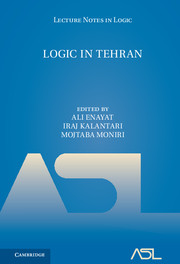Book contents
- Frontmatter
- Contents
- Preface
- Workshop and conference on logic, algebra, and arithmetic: Tehran, October 18–22, 2003
- Foreword
- Mathematical logic in Iran: A perspective
- Real closed fields and IP-sensitivity
- Categoricity and quantifier elimination for intuitionistic theories
- Primes and irreducibles in truncation integer parts of real closed fields
- On explicit definability in arithmetic
- From bounded arithmetic to second order arithmetic via automorphisms
- Local-global principles and approximation theorems
- Beatty sequences and the arithmetical hierarchy
- Specker's theorem, cluster points, and computable quantum functions
- Additive polynomials and their role in the model theory of valued fields
- Dense subfields of henselian fields, and integer parts
- A recursive nonstandard model for open induction with GCD property and cofinal primes
- Model theory of bounded arithmetic with applications to independence results
- Ibn-Sina's anticipation of the formulas of Buridan and Barcan
- Remarks on algebraic D-varieties and the model theory of differential fields
- A simple positive Robinson theory with LSTP ≠ STP
- Categories of theories and interpretations
- References
Specker's theorem, cluster points, and computable quantum functions
Published online by Cambridge University Press: 30 March 2017
- Frontmatter
- Contents
- Preface
- Workshop and conference on logic, algebra, and arithmetic: Tehran, October 18–22, 2003
- Foreword
- Mathematical logic in Iran: A perspective
- Real closed fields and IP-sensitivity
- Categoricity and quantifier elimination for intuitionistic theories
- Primes and irreducibles in truncation integer parts of real closed fields
- On explicit definability in arithmetic
- From bounded arithmetic to second order arithmetic via automorphisms
- Local-global principles and approximation theorems
- Beatty sequences and the arithmetical hierarchy
- Specker's theorem, cluster points, and computable quantum functions
- Additive polynomials and their role in the model theory of valued fields
- Dense subfields of henselian fields, and integer parts
- A recursive nonstandard model for open induction with GCD property and cofinal primes
- Model theory of bounded arithmetic with applications to independence results
- Ibn-Sina's anticipation of the formulas of Buridan and Barcan
- Remarks on algebraic D-varieties and the model theory of differential fields
- A simple positive Robinson theory with LSTP ≠ STP
- Categories of theories and interpretations
- References
Summary
Abstract.The present paper continues the work we began in [KalWel95, KalWel96, KalWel03, KalWel05].
Specker [Spe49] proved existence of a computable sequence of computable reals whose limit is not a computable real by using a noncomputable c.e. (computably enumerable) set. He did this by requiring his sequence to evade every computable point as a limit.
We study similar and generalized results in our filter-based approach to computable analysis and computable topology. We strategically construct evading sequences of basic open sets to generalize Specker's work. An evading sequence is a sequence of basic open sets such that any sequence of points with one point chosen to lie in each basic open set has the same cluster points as any other such sequence. This set of cluster points is the set of Specker cluster points of the evading sequence. We devise two methods for obtaining evading sequences such that all the Specker cluster points lie in the spectrum of a given avoidance function. We then use these methods to construct evading sequenceswhere their cluster points can be of one or more types (computable, avoidable, or shadow) and of any possible cardinality for each type. Finally, we use the acquired machinery to reveal two facts of the fine structure of the lower semi-lattice of domains of computable quantum functions under the relation of ‘subset’. Specifically, we show that we cannot always interpolate a computable quantum function between two nested computable quantum functions by constructing a pair of nested computable quantum functions whose domains differ in exactly one point. In contrast, we show that any time two nested computable quantum functions exist whose domains differ by at least two points, we can interpolate another computable quantum function between them.
Introduction.There are three classical approaches to general topology : Fréchet's abstract spaces, Hausdorff's neighborhood classes andKuratowski's closure classes. The fundamental objects with which one works in all these approaches are points. But a point can be viewed as a limit of a sequence of other points or the sole member of an intersection of a nested sequence of open intervals. These approaches to points are often useful.
- Type
- Chapter
- Information
- Logic in Tehran , pp. 134 - 159Publisher: Cambridge University PressPrint publication year: 2006
References
- 1
- Cited by

